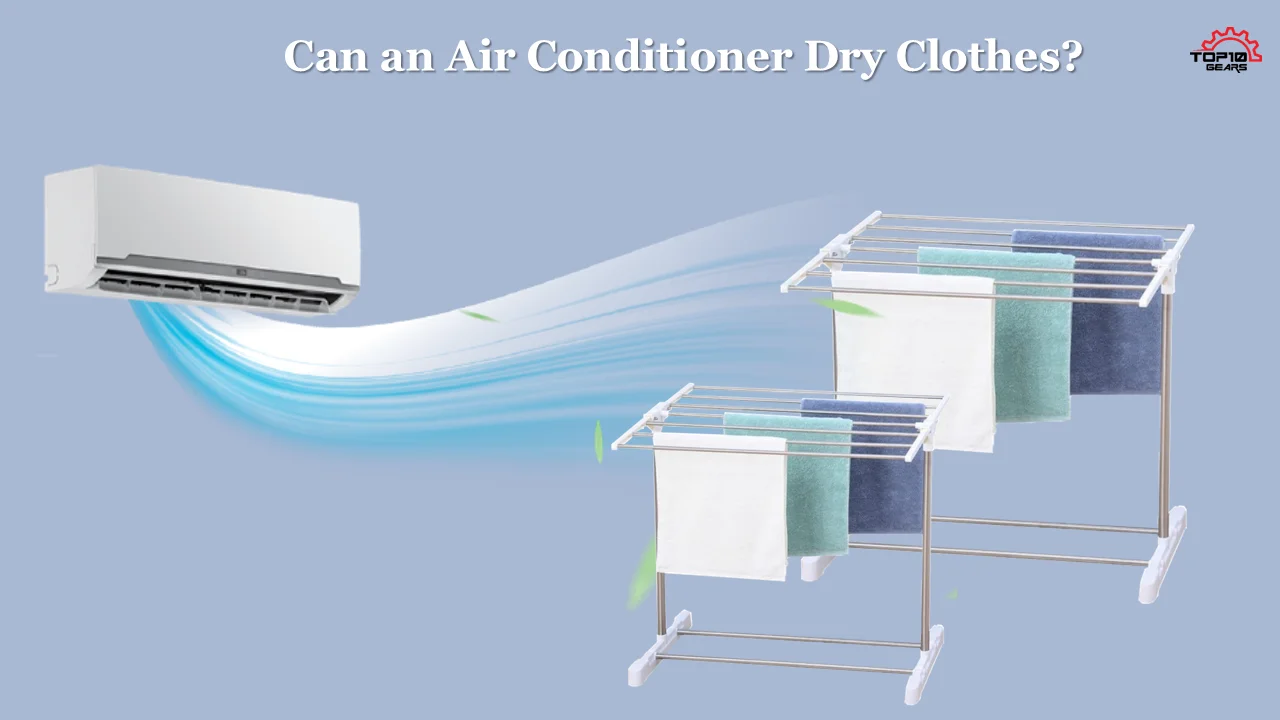
Clothes just out of the washing machine can hold about 2 litres of water. Drying it can be a challenge in winter, especially in humid and rainy climates. One option to this can be to hang your clothes indoors but sometimes, this is not enough as this action slows down drying thus being able to provoke stains, musty odor, and mold on clothes. For this reason, the best solution is to dry your clothes in the air conditioner. But how is that possible?
The short answer to the question “Can an Air Conditioner dry clothes?” is very simple. Yes, you can dry clothes in an air-conditioned room as it works as a dehumidifier and removes moisture from the air that helps in drying clothes.
This question first came to my mind when I visited my neighbor’s house and saw him drying his wet clothes in an air-conditioned room. I was a bit surprised and curious.
I enquired about it and he told me that using AC in dehumidifier mode helps the clothes to dry faster. Thereafter I dug deep into it on the internet.
I also asked my HVAC engineer friend and consulted my family doctor. I decided to share my findings in the form of this article. But before we dive deep into the topic, let’s first understand a few things about AC, their working, and dehumidification.

- Why do Wet Clothes dry faster in Summer and Warm Air than in Winter and Cold Air?
- What is the Best Temperature to Dry Clothes indoor?
- How Does an AC work?
- What is Dehumidification?
- AC as Dehumidifier
- Can an Air Conditioner Dry Clothes?
- Features of AC that Can Be Used for Drying Clothes
- Why You Should Dry Clothes in an Air-Conditioned Room?
- Why You Should Not Dry Clothes in an Air-Conditioned Room?
- Who Should Avoid Drying Clothes Indoors?
- How To Use an Air Conditioner To Dry Clothes
- Can you sleep in a room with drying clothes?
- Final Verdict
Why do Wet Clothes dry faster in Summer and Warm Air than in Winter and Cold Air?
It has to do with the temperature and humidity of the air. We all know that wet clothes dry due to evaporation. The clothes are wet due to water droplets on them that is in the form of liquid and their molecules are bonded to each other.
When a wet cloth is heated, the energy of its water molecules increases. They break the intermolecular forces and evaporate into the air as water vapors.
In summer, the air is generally warm, and dry(less humid) than it is in winter. It can absorb more moisture coming out of wet clothes. This means that the rate of evaporation is more and the water molecules on the clothes quickly evaporate and diffuse into the air. This helps to speed up the drying process.
On the other hand, in winter, the air is cold and humid, which makes it harder for wet clothes to evaporate. Due to this, it takes longer for them to dry.
Warm air can also help to circulate air around the room, which can further speed up the drying process.
What is the Best Temperature to Dry Clothes indoor?
The best temperature to dry clothes indoors is between 18-21°C. However, different types of clothes require different drying temperatures in the Dryer.
| S.No | Types of Clothes | Temperature |
| 1 | Cotton (Jeans and Towels) | High |
| 2 | Daily Use (T-shirts) | Medium |
| 3 | Sensitive Clothes (Sweaters) | Dry Flat |
| 4 | Stretchy (Yoga Pants) | Low |
The best temperature to dry clothes is between 18-21 °C.
If you are drying clothes outside, then the temperature doesn’t matter. If it’s hot, the clothes will dry faster. If it’s cold, the clothes will still dry but it will take more time.
How Does an AC work?
Most probably, this is the kind of question that comes to your mind when you’re cool at home while it’s unbearably hot outside? Or when you are comfortably at home, warm, while the cold night air clouds the windows.
In simple words, an air conditioner works by removing moisture and heat from the air. It does this by circulating coolant through a system of coils and then blowing cooled air into a room. The coolant absorbs heat from the air as it circulates through the coils, and this helps to reduce the humidity and temperature of the room.
To find out more, we must analyze the AC interior:
Components of an Air Conditioner
1. Indoor Unit: It contains the evaporator, which extracts the heat from the room and transmits it to the refrigerant gas. This unit also has temperature sensors that are connected to the thermostat.
2. Outdoor Unit: Contains the condenser and the compressor. This unit is the one that releases the hot air and, in it, the refrigerant gas goes from gas to liquid.
3. Other Parts: You can also find an expansion valve, a compressor, refrigerant gas, and a thermostat.
Functioning of an Air Conditioner
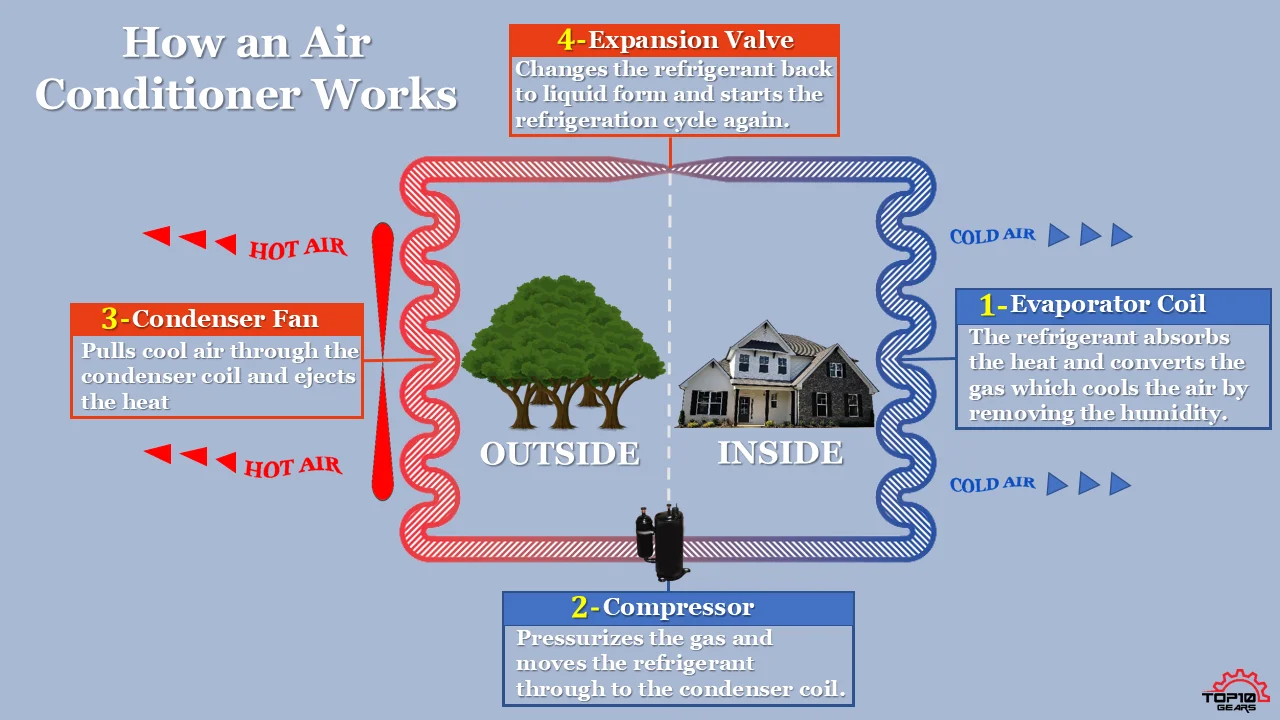
In general, an air conditioner uses a refrigeration cycle to reduce the temperature and humidity of the space. It doesn’t bring cold air into the room but extracts the heat from the room.
Refrigeration Cycle
The refrigeration cycle is repeated again and again to get the desired room temperature. This system includes the following steps:
- The outdoor unit is composed of a compressor and its function is to compress the gas. This gas, when compressing and changing to the liquid state, increases its temperature.
- This refrigerant liquid passes to the condenser and the sub-cooling process is carried out, emitting heat to the outside, like a radiator. It robs the liquid of heat and turns part of the liquid back into a gas, leaving another part as a gaseous liquid.
- This mixture passes to the expansion valve, which lowers the pressure and temperature of the gas.
- Now, overheating occurs which consists of passing the aforementioned mixture towards the evaporator. This happens because the gas has a lower temperature than the room temperature, so the heat leaves the room to cool the gas and leave it at the same temperature.
- The hot air enters the circuit, goes to the evaporator, and gives up its heat to the refrigerant gas, cooling the room.
- Then the compressor absorbs the heat from the refrigerant gas and expels it to the outside.
Broadly speaking, this is the process that a common AC follows and that is repeated step after step until the room cools down. The resulting air that we get from the AC is too dry and cooler compared to the surrounding air.
You can read more about the working of an air conditioner in our comprehensive article on How an air conditioner work.
AC Also Generate Heat
Air conditioners not only cool a room in summer but also heat it in winter. To do this, they use a system similar to that of cooling but acts as a heat pump. The refrigeration cycle is reversed, with a reversing valve.
The heat generated by the compressor is transferred to the refrigerant liquid. When the air inside the room comes in contact with the refrigerant gas, the gas cools and the air heats up and is expelled outside. As you have seen, the circuit is the reverse, it sucks in cold air and expels hot air.
Not only that, but modern ACs also work as a dehumidifier, which you can activate by using the Dry mode. This function aims to eliminate humidity in homes. Next, we will explain it better.
What is Dehumidification?
Dehumidification by definition is the reduction of relative humidity of the environment of a room or a closed place, something that you can achieve by a dehumidifier.
Unfortunately, in the vast majority of homes, humidity problems can occur and, if it remains for a long time, it could cause significant damage to your home.
A dehumidifier is a device that can condense moisture in space and prevent it from getting impregnated on walls, as well as on other surfaces. Thus preventing the problems mold growth.
AC as Dehumidifier
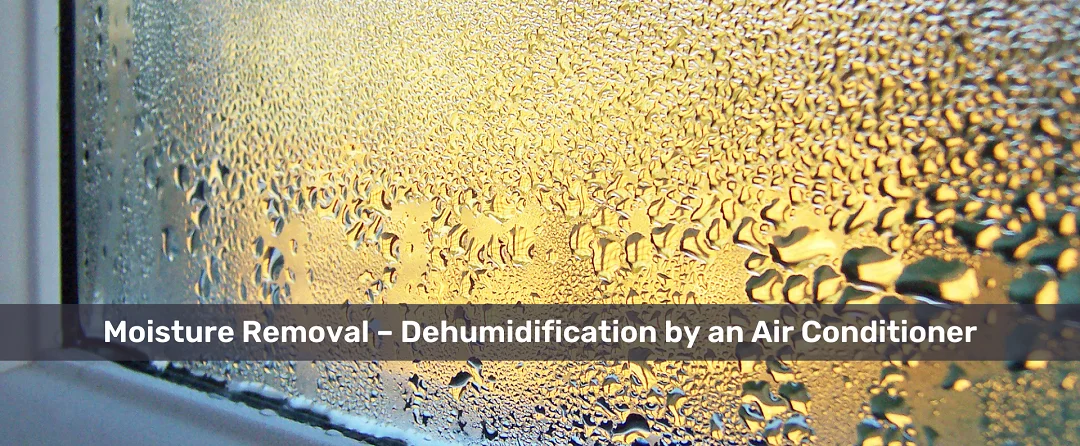
If you are about to buy an air conditioner or you have just purchased one, we would like to tell you that some units have a dehumidifier function, which can help you reduce the negative effects of humidity for some time.
An air conditioner helps reduces humidity inside the home. Despite this, in some cases, it is not enough, because an air conditioner was designed to cool a room.
The dehumidification function is just an additional feature of the air conditioner that can be very useful for small apartments or medium-sized rooms.
Can an Air Conditioner Dry Clothes?
Yes, an Air Conditioner can dry clothes. An AC in Dry mode works as a dehumidifier and removes moisture from the space. It makes the air dry, thereby increasing the rate of evaporation and drying the wet clothes.
However, there are a few things you need to keep in mind. First of all, air conditioners are designed to cool down a room, not necessarily dry clothes. This means that it will take longer to dry your clothes using an air conditioner than a traditional clothes dryer.
Additionally, you’ll want to make sure that you hang your clothes in a well-ventilated area so that they don’t get too musty.
Features of AC that Can Be Used for Drying Clothes
There are many features of an air conditioner that is helpful in drying clothes. They are listed below
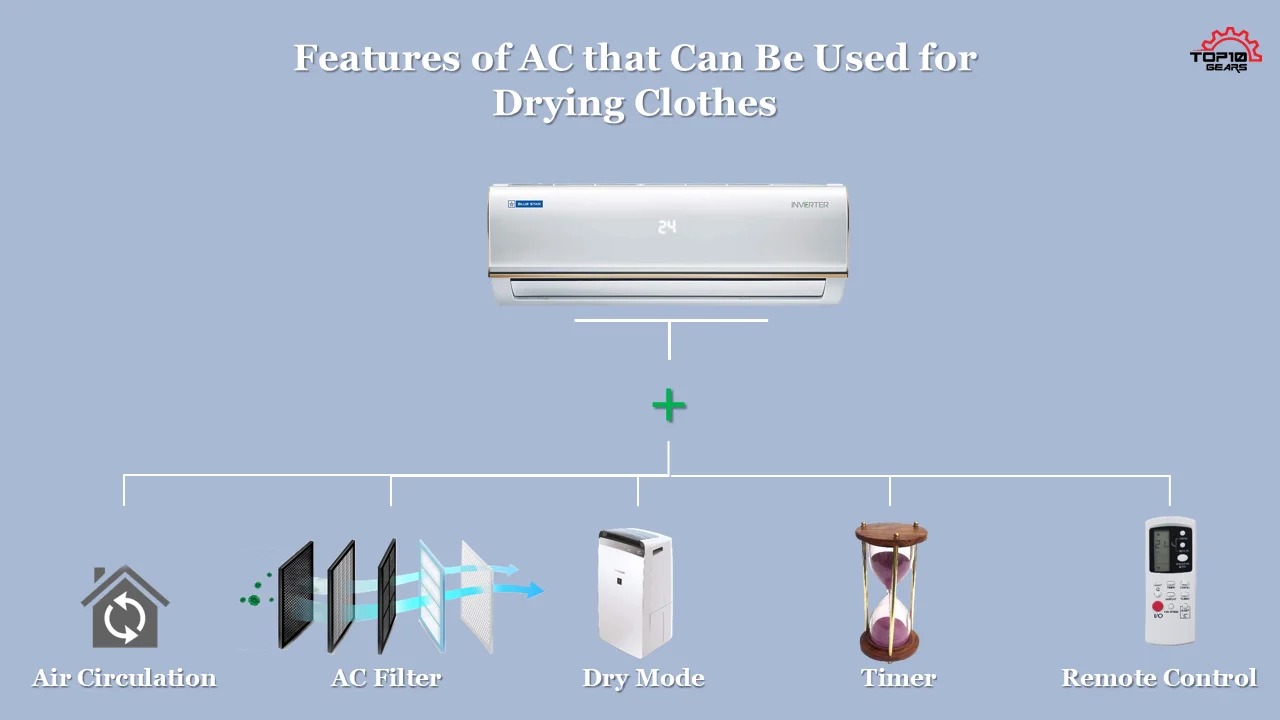
AC Functions as a dehumidifier in Dry Mode
As I mentioned before, one of the features that the AC has is the Dry mode. The main objective of this mode is to remove humidity from the homes. Therefore, we can say that it acts as a dehumidifier.
Although Dry mode is a dehumidifier, it also helps to air-condition homes. However, it is not an air conditioning system like the Cool function, but by activating the Dry option we can reduce both the temperature of the room and its humidity.
An Air Conditioner reduces the humidity of the space, making it easier for wet clothes to dry fast.
These low humidity conditions offered by an Air conditioner allow the clothes to dry faster. All humidifiers speed up the drying process of clothes because they remove moisture.
They do it naturally, without using high temperatures, so they do not damage clothes. They are very useful in humid climates where you will benefit not only from better drying of clothes but also from maintaining appropriate humidity levels for well-being.
Air Circulation
An air conditioner helps to circulate air inside the room, which can speed up the drying process.
AC Timer
This feature of an air conditioner allows you to set a specific time for the AC to run so that you can check on your clothes periodically.
AC Filter
Helps to remove dust, pollen, spores or other harmful substances from the air inside the room. Thereby, preventing the “musty” smells from the clothes.
Remote Control
This allows you to control the air conditioner from a distance so that you can adjust the settings without having to get up.
Why You Should Dry Clothes in an Air-Conditioned Room?
The correct AC can help you a lot in drying your clothes. Therefore, it can give you’re the following advantages:
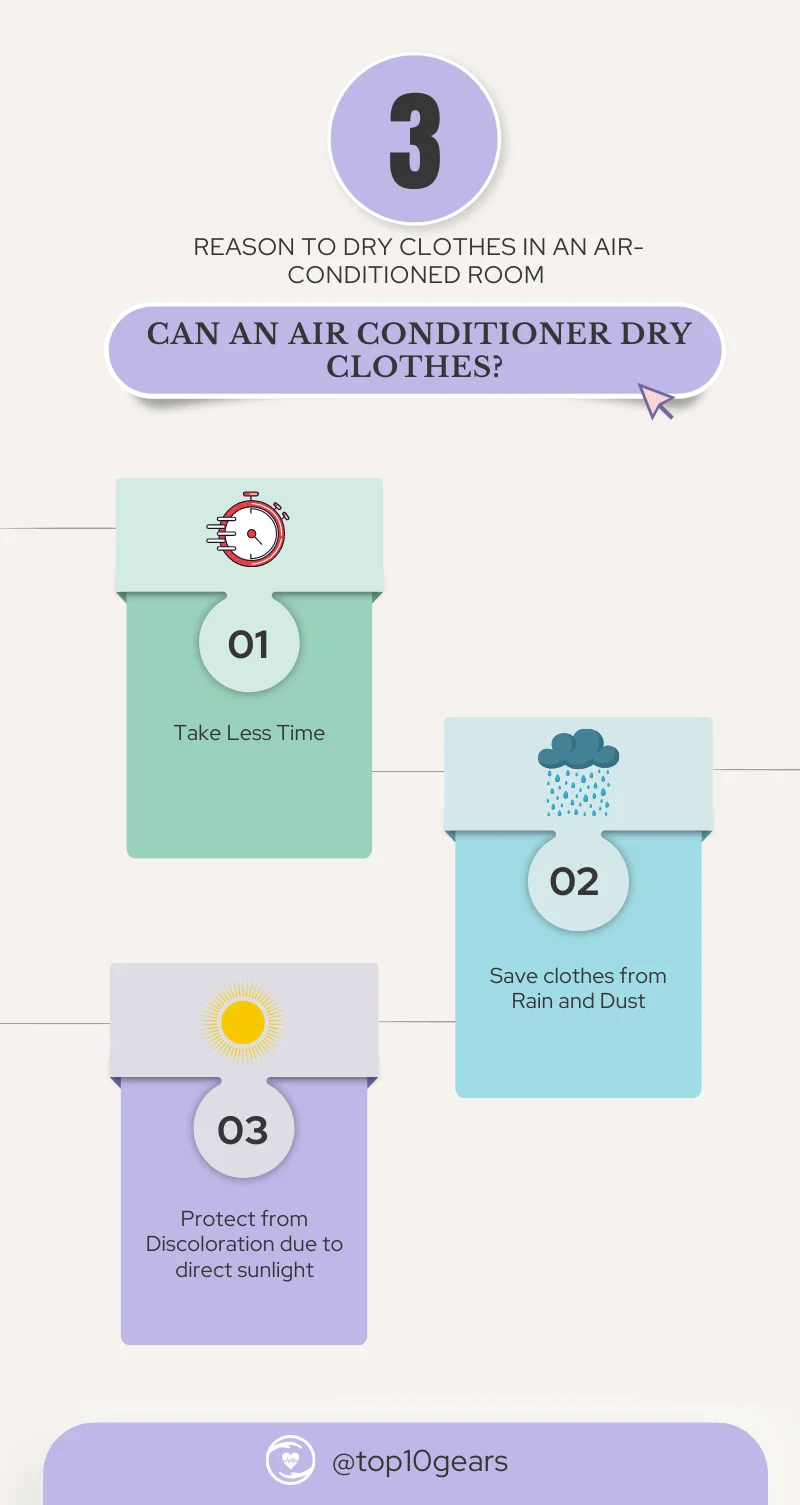
Take Less Time
The Air conditioner reduces humidity and increases the airflow of the room which helps the water molecules inside the clothes evaporate more quickly than other methods.
Save from Rain and Dust
When we wash clothes and hang them outside, dust molecules stick to wet clothes more easily. Therefore, the AC prevents this from happening since the garment remains inside the room. The AC also helps dry clothes on those rainy days more quickly and efficiently.
Protect from Discoloration due to direct sunlight
Thanks to an AC, we will no longer have discolored clothes due to exposure to the direct sun and UV rays. as it works on the same principle as bleaches, why?
Because the high-intensity photons that the sun’s rays emit, modify or break the bonds of the molecules that are responsible for reflecting a certain type of light, and that allows us to appreciate a certain color.
Why You Should Not Dry Clothes in an Air-Conditioned Room?
There are some ACs that unfortunately instead of eliminating or helping to maintain an adequate level of humidity in the room, increase it, creating an opposite function to what we are looking for. This will depend on the brand and model of the AC, therefore, this equipment can produce disadvantages such as:
Maintain the quality of your clothes
Placing your clothes inside your room with the AC on for many hours may damage the fibres of your garment, making them weaker and allowing them, over time, to lower their quality and may break.
May distribute mold spores
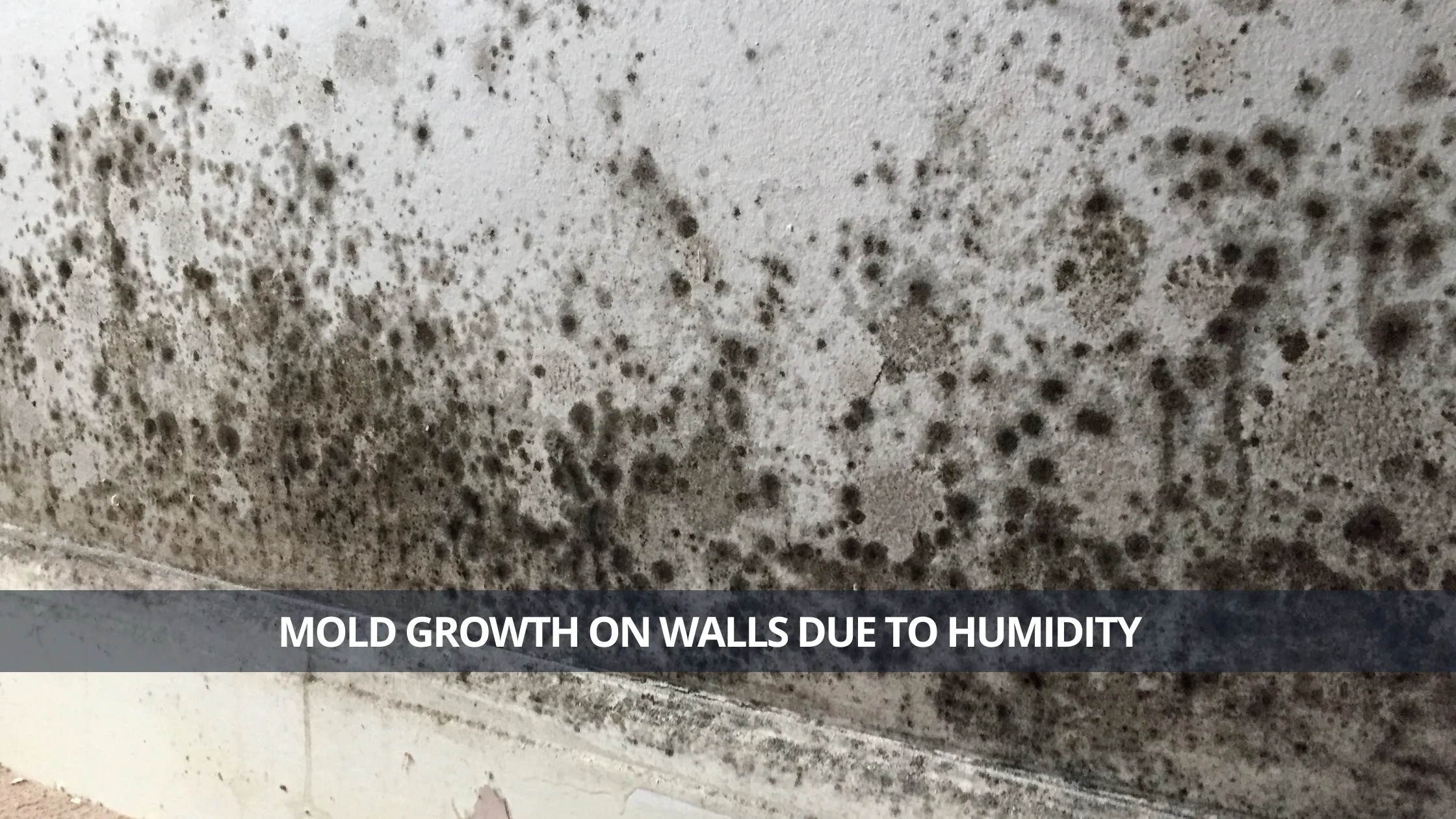
Mold can enter your home through vents, heating, and air conditioning systems. They can grow in humidity places, and AC filters are a good option. This negatively affects your environment, they can even stick to your clothes.
Unwanted Scent
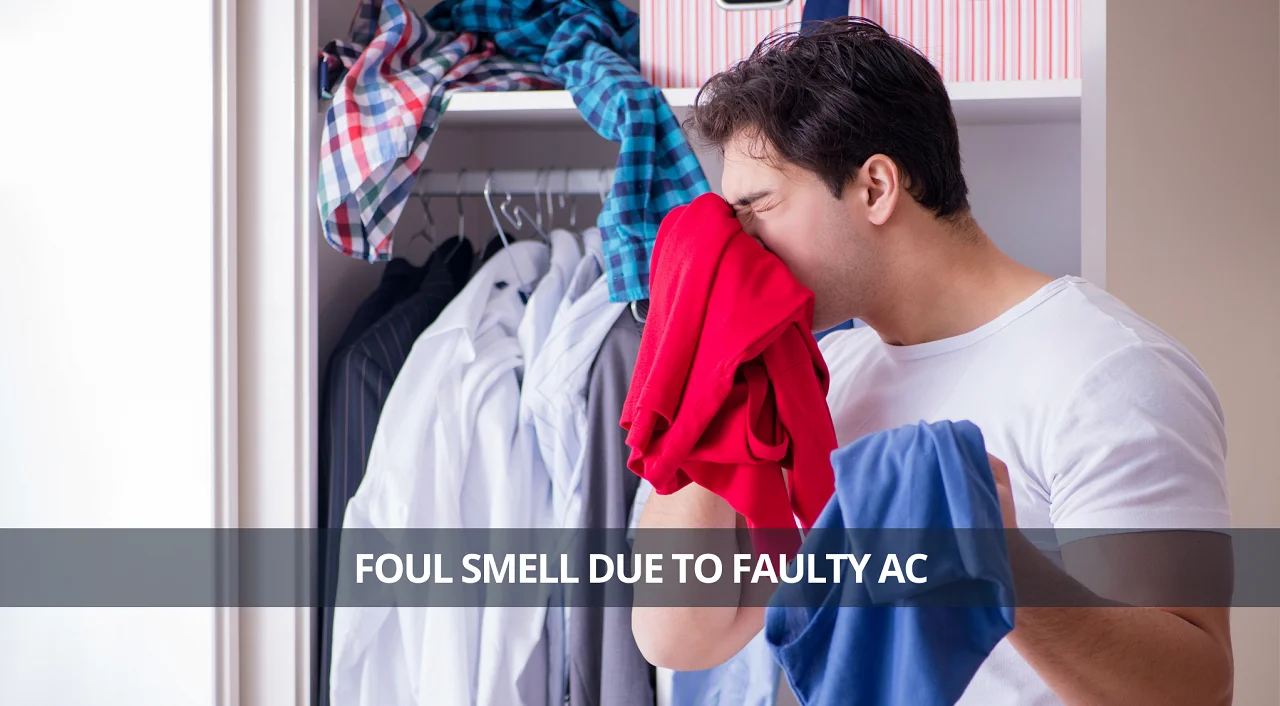
If you think drying your clothes in a room with AC is a good idea, then you should take a good look as you could create even more humidity and therefore, your clothes, as the hours go by, smell bad. This is because the humidity creates a chain effect creating the growth of fungi and these produce a bad smell.
Can attract moths
The AC may produce a suitable temperature for the moths. This happens when the AC does not remove moisture and instead creates a pleasant environment, thus allowing it to enter your home to lay its eggs and use your clothes as food.
Who Should Avoid Drying Clothes Indoors?

Humidity in a closed space due to drying clothes indoors can be bad for health, especially for those who suffer from allergies such as asthma patients or patients with other allergies. The frequent change in temperature and humidity can cause coughing, eyes itching, or constantly sneezing.
The humidity also encourages the growth of different types of allergens such as fungi, molds and mildew. These pathogens can produce the same allergic reactions as pollens or mites and lead to rhinoconjunctivitis (itching of the nose, red eyes, lacrimation, nasal congestion, sneezing, and generally liquid mucus) to a dry cough or even bronchospasm in the most severe cases.
How To Use an Air Conditioner To Dry Clothes
The time it will take to dry the clothes will depend on the humidity of the environment, the size of the room, and how wet the clothes are.
Can you sleep in a room with drying clothes?
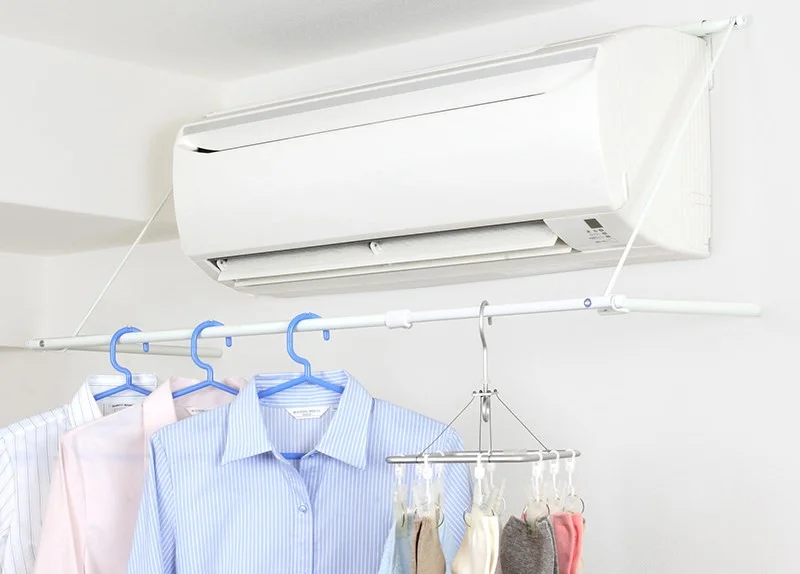
There is a lot of debate over whether or not it is okay to sleep in a room with the air conditioning on while clothes are drying. Some people say that it’s perfectly fine, while others believe that it can cause problems like mildew growth. So, can You sleep in an air conditioning room with drying clothes?
No, one should not sleep in an air conditioning room with wet clothes because it can cause mold spores to form and potentially make you sick if breathed in for long periods of time. The air conditioner will circulate the moist air and create an environment that is conducive to mold and mildew growth.
There is also a risk of getting a fungal infection (yeast infection) that can develop in moist and damp conditions generated due to wet clothes and an air conditioner. The fungi that cause these infections thrive in moist environments, so it’s important to keep the area as dry as possible.
Additionally, the temperature of your body will significantly drop which can weaken the immune system and make you more susceptible to bacteria, viruses, and other pathogen infections.
Continuously sleeping in an air conditioning room with wet clothes for a longer period of time can also cause skin problems such as rashes, itchiness, and dryness. It can also aggravate conditions like eczema and psoriasis.
So, it’s best to avoid sleeping in a room with the air conditioner on while clothes are drying.
Final Verdict
While an air conditioner can technically be used to dry clothes, it’s not the most effective method and there are better ways to do it such as Clothesline or rack drying. However, if you’re in a pinch and need to dry your clothes quickly like in the rainy season, following the steps above will help you to get the best results possible.
For your air conditioner to help you dry your clothes, you must take into account the brand and type of AC you have at home. So, if you plan to invest in an AC, make sure that apart from cooling and acting as a heater, it can also act as a dehumidifier so that you can get the most out of your AC.
You can also check our extensive AC buying guide that will help you choose the one that will work best in different spaces.
Did you find this blog post helpful? Let us know in the comments below or on our website. And be sure to share your own tips for drying clothes quickly! Thanks for reading and happy drying!
Thanks for reading and happy drying! 🙂



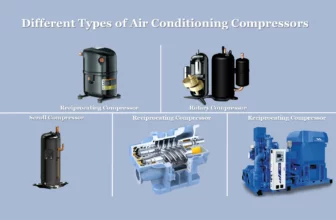


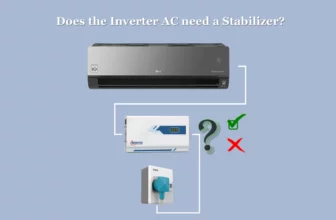


Very interesting research, with clear helpful answers, However, there are no indications towards the running costs,what is the usual energy in and ou put to having an AC on for say, seveal hours? I suppose different makes have larger or smaller moters, so this may be a difficult question, perhaps a general idea regarding this may be helpful. Thank you . Eve Cole.
[…] mode also come in handy when we want to dry your wet clothes indoor. Yes, an air-conditioner help in drying your wet clothes as it works as a […]
[…] Read More: Can an Air Conditioner Dry Clothes? […]
[…] to Top 10 Gears, an air conditioner can be efficient in drying clothes if the clothes are placed in a small, closed […]